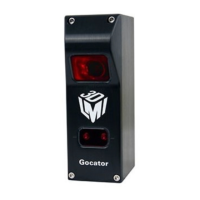Gocator Line Profile Sensors: User Manual
Gocator Web Interface • 125
Various settings can affect how the Material settings behave. See Spots and Dropouts on page 149 for
more information.
Camera Gain and Dynamic Exposure
You can set camera gain and dynamic exposure to improve data acquisition.
Setting Description
Camera Gain
Analog camera gain can be used when the application is severely exposure limited, yet
dynamic range is not a critical factor.
Digital camera gain can be used when the application is severely exposure limited, yet
dynamic range is not a critical factor.
Dynamic Exposure
Sensitivity controls the exposure that dynamic exposure converges to. The lower the
value, the lower the exposure Gocator will settle on.
The trade-off is between the number of underexposed spots and the possibility of
over-exposing.
Threshold is the minimum number of spots for dynamic exposure to consider the
profile point that make up the spot valid. If the number of spots is below this
threshold, the algorithm will walk over the allowed exposure range slowly to find the
correct exposure. Because this is slow, the Threshold value typically should be kept as
low as possible, so this slow search is not used.
These settings let you set tune how dynamic exposure settles on an exposure for a
scan. For more information on Dynamic Exposure, see Dynamic Exposure on page 118.
Alignment
Gocator sensors are pre-calibrated and ready to deliver profiles in engineering units (mm) out of the box.
However, alignment procedures are required to compensate for sensor mounting inaccuracies, to align
multiple sensors into a common coordinate system, and to determine the resolution (with encoder) and
speed of the transport system. Alignment is performed using the Alignment panel on the Scan page.
Once alignment has been completed, the derived transformation values are displayed under
Transformations in the Sensor panel; see Transformations on page 115 for details.
Alignment States
A Gocator can be in one of two alignment states:Unaligned and Aligned.
State Explanation
Unaligned The sensor or sensor system is not aligned. Profiles are reported in sensor coordinates.
Aligned
The sensor is aligned using the alignment procedure (see Aligning Sensors on the next
page) or by manually modifying the values under Transformation in the Sensor tab
on the Scan page (for more information, see Transformations on page 115).
Alignment State
